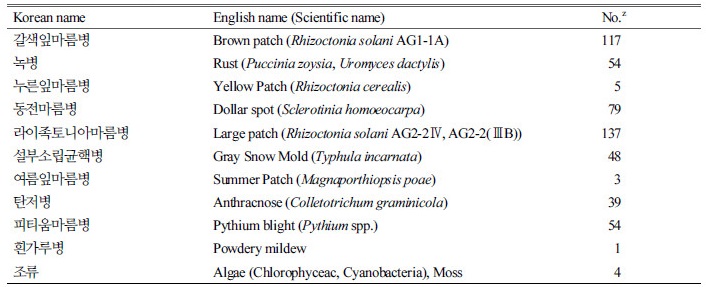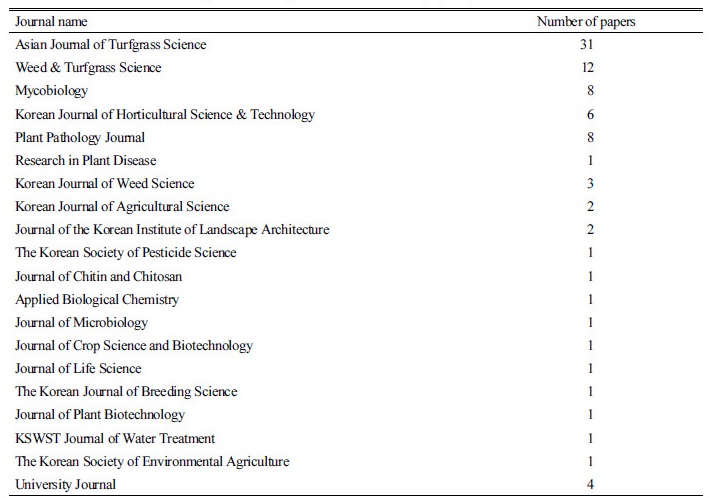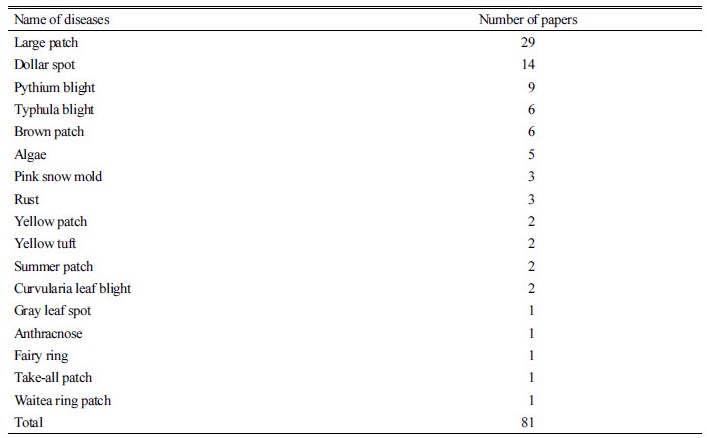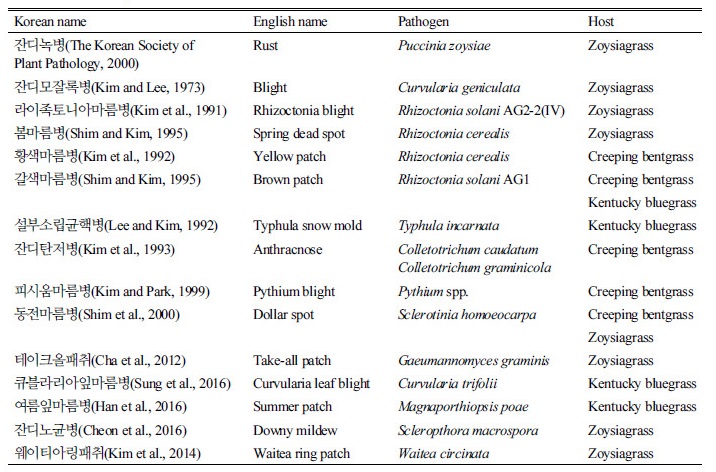서 론
인간은 10세기 이상 인간의 삶의 질을 향상시키는데 잔디를 이용하였다. 잔디는 기능적인 면, 스포츠 및 휴양적인 면 그리고 미적인 측면에서 인간에게 다양한 이점을 제공한다. 기능적인 면에서 토양 침식 제어, 먼지발생 방지, 대기 오염 정화, 소음 감소, 냉각 기능 등 다양한 공익적 이점을 제공한다. 또한 운동장, 야구장 및 골프장 등에 사용되어 상해방지 및 아름다운 미관을 창출하는 등 인간의 삶의 질의 향상에 기여한다(Beard and Green, 1994). 이러한 이점 때문에 잔디의 활용도가 증가되고 이에 따른 잔디산업의 경제규모도 계속 증가하고 있다. 미국에서는 잔디로 인하여 총 579억 달러의 생산 효과, 822,849개의 일자리 및 351억$의 부가가치를 창출하는 것으로 알려져 있다(Haydu et al., 2006). 우리나라도 공원, 골프장, 도심녹화, 스포츠필드 등 잔디의 활용도가 증가하면서 잔디산업의 규모가 점차 커지고 있다(Choi and Yang, 2006; Jang et al., 2011; Lee et al., 2001; Yonn et al., 2006). 뿐만 아니라 잔디재배면적도 점차 증가하여 2011년 잔디 재배면적은 3,056 ha로 2001년에 비하여 17.8%가 증가하여 중요한 농가의 수입원이 되었으며, 잔디의 고급화에 따른 한지형 잔디의 판매량 및 종자 수입량도 증가하였다(Choi and Yang, 2006; Korea Forest Service, 2012; Lee et al., 2001; Yonn et al., 2005; Yonn et al., 2006). 이처럼 잔디가 다양하게 활용되고 고급화되면서 잔디에 발생되는 병해에 의한 피해양상도 다양화되고 증가하게 되었다(Hyun et al., 2012). 특히 집약적인 관리가 요구되는 골프장 및 스포츠 필드의 경우 잔디병의 피해를 방제하기 위하여 막대한 비용과 노력이 소요되고 있다(Yoo et al., 2009). 또한 고품질의 그라운드면을 유지하기 위해 도입된 한지형 잔디의 활용이 증가되면서 새로운 병들 출현과 동시에 발병율 또한 증가하고 있는 실정이다. 국내 잔디연구의 짧은 역사에도 불구하고 잔디병은 그 중요성 때문에 국내에서도 잔디 병리학적 연구노력이 다양하게 이루어졌다. 이에 한국잔디학회 창립 30주년에 즈음하여 국내 잔디병 역사를 정리해보고 앞으로의 잔디병리 분야의 발전방향을 고찰해 보고자 한다.
우리나라 잔디병해 연구사
우리나라 잔디병해 연구사를 알아보기 위하여 국내 잔디병에 대한 연구논문을 검색하였다. 잔디와 관련된 논문을 주로 다루고 있는 국내학술지인 Weed & Turfgrass Science, 한국잔디학회지, 원예과학기술지 등에서 잔디병과 관련된 논문을 검색, 분석하였다. 그 외에도 한국교육학술정보원에서 제공하는 논문탐색시스템(RISS, http://www. riss.kr/index.do)을 이용하여 잔디병에 대한 논문을 탐색하였다. 국내 잔디병과 관련된 논문은 약 80여 편으로 잔디 육종, 관리 분야의 논문 수보다는 적지만 잔디 해충이나 잡초분야의 논문 수보다는 많았다. 국내 잔디병에 대한 최초의 연구논문은 1930년에 조선총독부 농업시험장휘보(農業試驗場彙報)에 게재된 녹병에 대한 보고이다(The Korean Society of Plant Pathology, 2000). 이후 국내 학회지에 최초로 게재된 잔디병 보고는 1973년 한국균학회지에 게재된 Curvularia에 의한 벤트그래스의 모잘록병(立枯病)에 대한 논문이다(Kim and Lee, 1973). 1990년 이전에는 위의 두 연구 외의 잔디병에 대한 보고는 전무한 상태이다.
최초의 연구논문이 게재된 후부터 지금까지 다양한 학술지에 잔디병과 관련된 내용의 연구논문이 게재되었는데, 한국잔디학회지가 전체 논문의 50%를 차지하였으며 이후 한국잔디학회지와 한국잡초학회지가 통합되어 만들어진 Weed & Turfgrass Science에 15%가 게재되어 잔디병과 관련된 대부분의 논문은 한국잔디학회에서 발행하는 학회지에 게재되었다. 그 외에도 한국균학회지, 한국원예학회지, 한국식물병리학회지 등에 일부 게재되고 있다(Table 1).
연도별 논문 수는 1990년대 초까지는 잔디병해관련 연구의 암흑기로서 4편에 불과했다. 1990년대 중반 이후 논문 수가 점차 증가하기 시작하여 2009년 까지 21편의 관련논문이 게재되었으며 2010년부터 2013년까지 4년간 29편으로 가장 많은 수의 논문이 발표되었다. 이후 매년 2-4편 정도의 논문 게재 수를 유지하고 있다(Fig. 1). 1990년대 이후 논문 수가 증가한 것은 이 시기에 골프장이 늘어나면서 잔디병에 대한 관심이 높아지게 되었고, 이와 더불어 1989년 한국잔디연구소의 설립, 1994년 삼성잔디환경연구소의 설립 등 잔디연구기관들의 등장이 잔디 병해의 학문적 접근에 중요한 계기가 되었을 것으로 사료된다.
잔디 종류별 논문 수는 1991-1999년에 난지형잔디 8편, 한지형잔디 12편이었고 2000-2009년에는 난지형잔디 6편, 한지형잔디 16편으로 한지형잔디병에 대한 연구가 급격하게 증가했다. 2010-2017년에는 전반적으로 논문 수가 증가하여 난지형잔디 24편, 한지형잔디 27편으로 나타났다(Fig. 2). 2000-2009년에 한지형잔디에 대한 연구가 증가한 것은 2002월드컵축구대회를 계기로 축구장과 스포츠 구장에 켄터키블루그래스의 보급이 확대된 것이 주된 원인으로 판단된다. 이에 따른 영향으로 한지형잔디로 조성된 골프장이 늘어나고 기존 한국잔디로 조성된 골프장의 경우에도 답압이 집중되는 지역 특히 티잉그라운드 및 그린 주변에 켄터키블루그래스를 조성하면서 한지형잔디 면적이 급격하게 증가하였다. 이에 따라 한지형잔디에 발생하는 병해에 대한 연구가 증가하게 된 것이라 사료된다.
연구 분야별로는 잔디병해 방제에 대한 논문이 전체 논문 수 대비 42.8%를 차지하였고, 병해 생태 23%, 잔디병해 보고 및 분류 19.7%, 유전 7.6%, 약제 저항성 6.5%를 차지하였다(Table 2).
가장 많은 연구가 이루어진 잔디병해 방제분야는 생물학적, 친환경적 방제 그리고 화학적 방제로 나누어서 보면, 방제 논문 중 생물학적 방제부분이 53.5%, 친환경적 방제부분이 28.1%, 화학적 방제부분이 28.1%를 차지하였다(Table 2). 화학적 방제를 다룬 논문보다 생물학적, 친환경적 방제에 관련된 논문이 3배 이상 많았다. 이렇게 생물학적 친환경적 방제와 같은 환경친화적인 연구가 많았던 것은 1990년대에 골프장 건설로 인한 환경파괴의 우려와 농약사용량 증가에 따른 환경문제가 사회이슈로 대두되면서 이에 대한 대안을 찾는데 관심이 높았음을 보여준 결과라고 할 수 있다. 잔디병해에 대한 생물학적 방제연구는 주로 항균성 미생물 Trichoderma (Shim et al., 1997; Yeom, 1999), Psudomonas (Chang et al., 2009; Suh et al., 1999), Streptomyces (Jeon et al., 2016), Bacillus (Kim et al., 2005) 등의 분리 및 항균성 검정에 대한 논문들이 많았으며, 현재 Bacillus 속 세균을 이용하여 개발된 잔디용 생물농약 6품목이 등록되어 사용되고 있다(Korea Crop Protection Association, 2017). 친환경적 방제에 대한 연구는 목초액, 식물추출물, 약용식물, 후박 등을 이용한 연구가 시도 되었으며(Kang et al., 2013; Kim et al., 2006; Kwon et al., 2010; Lee and Huh, 2002; Yoon et al., 2013) 가축분뇨를 이용한 잔디생육 관리 및 대취분해, 라이족토니아마름병 방제에 대한 연구도 이루어졌다(Ryu et al., 2014). 그 외에도 생물학적 방제의 제한적 효과를 보완하기 위하여 시비 및 농약의 혼용, 잔디 초종의 혼식 등에 대한 다양한 연구가 시도되었다(Jang et al., 2011; Park, 2003; Shim et al., 1997). 화학적 방제는 대부분 농약의 약효 검정 및 잔디용 농약등록을 위한 연구에 치중되었으나 최근에는 농약사용의 효율성을 향상시키기 위한 노즐의 형태, 살포방법 등에 대한 진전된 연구도 있었다(Chang et al., 2012).
잔디병 생태에 관한 연구는 대부분 병 발생에 대한 보고가 많았으나 최근에는 라이족토니아마름병의 토양중 밀도변화를 탐색(Min et al., 2014)하거나 동전마름병의 잔디밭 토양중 서식처를 확인(Lee et al., 2015)하는 등의 진일보한 생태에 관한 연구도 시도되었다.
잔디병해 별로는 라이족토니아마름병(large patch)에 대한 연구가 32.9%로 가장 많았으며 다음으로 동전마름병(dollar spot) 15.9%, 피티움마름병(Pythium blight) 10.2%, 설부병(Typhular blight) 6.8%와 갈색마름병(brown patch) 6.8% 순으로 나타났다(Table 3). 라이족토니아마름병의 연구 비율이 높은 것은 라이족토니아마름병의 주요 기주인 한국잔디가 국내에서 가장 많은 식재 면적을 차지하고 있고(Choi and Yang, 2006), 토양전염성병해로서 잎과 줄기에 발생하는 병에 비해 방제가 어렵기 때문이다. 특히 골프장의 경우 가장 넓은 면적을 차지하는 페어웨이에서 병이 발생하기 때문에 방제비용이 증가되고, 방제에 따른 농약사용량의 증가로 환경오염 유발에 대한 사회적 우려가 증가되면서 이에 대한 해결 방안에 관심이 높아졌기 때문으로 본다(Shim et al., 1995). 동전마름병과 피티움마름병은 주로 한지형 잔디를 대상으로 연구가 되었다. 1990년대 이전에는 발병율이 낮아 크게 문제가 되지 않았으나 약제를 연용하면서 병원균의 약제내성 문제가 대두되면서 1990년대 후반부터 2000년 초까지 이와 관련된 연구에 관심이 집중되었다(Kim and Park, 2002; Shim et al., 2001). 피티움마름병은 metalaxyl에 대한 약제내성이 보고되었고(Kim and Park, 2002) 동전마름병은 iprodione, thiophanate-methyl에 대한 약제내성이 보고되었다(Kim et al., 2010; Shim et al., 2001).
국내에서 처음으로 보고된 잔디병은 15종류이며 1990년대에 라이족토니아마름병(Rhzoctonia blight), 봄마름병(spring dead spot), 황색마름병(yellow patch), 갈색마름병(brown patch), 설부소립균핵병(Typhula snow mold), 잔디탄저병(anthracnose), 피티움마름병(Pythium blight)이 보고되었다. 2000년대에는 동전마름병(dollar spot), 테이크올패취(take-all patch), 페어리링(fairy ring), Waitea ring patch, Curvularia leaf blight, 여름잎마름병(summer patch), 잔디노균병(downy mildew)이 보고되었다(Table 4). 이 외에도 현장에서 발생되어 문제가 되고 있는 병이 다수 있지만 국내에서 학술지에 보고가 되지 않은 병해들이 아직 많다. 미국의 경우 잔디병은 엽고병 22종, 설부병 6종, 잎 ․ 뿌리병 15종, 기타 9종 등 총 52종류가 발생하는 것으로 보고되어 있다(Smiley et al., 2005). 우리나라에 비하여 37종류가 더 많다. 미보고 된 병해의 효과적 관리를 위하여 학술적인 분류와 병원균의 발병생태에 대한 연구가 반드시 필요하다고 사료된다.
잔디병 방제용 농약 연구 현황
국내의 잔디병 방제는 화학적 방제가 주를 이루며 1990년 이래 잔디용농약 고시 및 등록시험이 활발하게 이루어졌다. 1990년 당시 잔디용으로 고시 및 등록된 살균제 수는 4품목에 지나지 않았으나 2000년까지 10년간 약 24개 품목으로 늘어났고 2010에는 163품목, 2018년에 461개 품목으로 대폭 증가하였다(Fig. 3). 방제 대상 병해는 녹병, 동전마름병, 탄저병, 피티움마름병, 갈색잎마름병, 누른잎마름병, 라이족토니아마름병, 조류, 설부소립균핵병, 여름잎마름병, 흰가루병 등 11개 병해에 등록되어 있다(Table 5). 현재 등록된 살균제 수는 461개로 결코 적은 수는 아니지만 대상병해가 11종으로 국내 보고된 병해 15종에 미치지 못하는 실정이다. 농약이 등록되지 않은 대상병해는 방제할 약제가 없어 방제에 어려움을 겪고 있는 실정이다. 미국의 경우, 2017년 Chemical Control of Turfgrass Diseases (Kentucky university)에 의하면 26가지 잔디병에 대한 살균제의 효과와 사용방법에 대한 연구결과를 상세히 보고하고 있다(Paul and Bruce, 2017). 국내에 아직 등록된 약제가 없는 병해의 경우 미국의 농약평가 자료에 의존하고 있는 실정이다. 국내에서도 보고된 병해에 대한 다양한 살균제가 등록되고, 다양한 방제 방법이 연구되어 농약사용의 효율을 제고함은 물론 농약 오남용에 따른 약제내성 문제 등을 최소화시켜야 할 것으로 본다.
Table 5. Number of registered chemicals for turfgrass disease in Korea 2017.

|
|
|
zNumber of registered chemicals. |
|
향후 잔디병리 연구의 방향
향후 우리나라 잔디병리학 발전을 위한 우선 과제는 국내에 발생되는 잔디병의 학문적인 보고와 더불어 보고된 잔디병에 대한 병명의 정립이다. 미국식물병리학회에서 발행된 Compendium of turfgrass diseases (The American phytopathological society)에 의하면 약 52종의 잔디해가 보고되어 있다(Smiley et al., 2005). 이에 비해 국내에서 현재까지 보고된 잔디병은 15종류에 불과하다. 실제 현장에서 문제가 되고 있지만 학술적으로 발생이 보고되지 않은 병들이 다수 확인되고 있다. 여름잎마름병(summer patch)의 경우 국내에서 10년 이상 켄터키블루그래스에 발생되어왔으나 병원균의 분리와 접종시험에 의한 재현이 어려워 2016년에서야 비로서 병발생이 보고되었다(Han et al., 2016). 이로 인하여 방제약제가 등록되지 않아 약제선정을 위해 외국자료에 의존하는 결과를 가져왔다. 또한 spring dead spot과 red thread의 경우 국내에서 실제 발생하고 있으나 학문적으로 보고되지 않고 있다. 또한 미국과 일본에서는 바이러스병과 박테리아병에 대한 발병 보고(Smiley et al., 2005; Tanaka, 2003)가 있으나 국내에서 아직 이들 병에 대한 보고가 없다. 이들 병들에 대한 학문적 조사 및 연구가 필요하다. 지금까지 보고된 병들의 경우에도 병명에 대한 정립이 정확히 되지 않아 외국이름을 그대로 사용하거나 또는 한국명 사용에도 혼선이 생기는 경우가 있다. 예를 들어 우리나라에서는 Leptosphaerulina leaf blight, Curvularia disease, Bipolaris disease를 모두 엽고병 또는 입고병이라 부른다. 잔디병의 명명에 대해서는 잔디병리학자들의 주도적인 역할이 필요하고 한국식물병리학회와의 적극적인 협력을 통하여 잔디 병명의 정립이 우선되어야 할 것이다.
우리나라의 잔디병 연구역사는 약 30년 정도로 미국에 비하여 그 역사가 비교적 짧은 편이다. 하지만 잔디는 대부분 골프장을 비롯한 스포츠, 레저분야에서 활용이 증가되고 있으며 인간의 삶 속에서 인간과 매우 밀접하게 활용되고 있고 중요한 소재로 여겨지고 있다. 이에 따라 잔디를 건강하게 관리하기 위한 잔디병 연구는 필수적이다. 잔디병 연구가 활성화되기 위해서는 잔디병에 대한 기초연구가 무엇보다 중요하다. 그 동안의 연구 결과들을 보면 대부분 응용연구나 농약에 대한 연구에 치중된 면이 있다. 이러한 연구들도 중요하지만 먼저 국내에서 발생하는 잔디병의 동정과 보고가 우선되어야 할 것이다. 또한 잔디 병해의 효과적인 관리를 위하여 발병원인과 관련한 병원균 생리, 생태 및 환경요인 등에 대한 연구가 이루어져야 할 것으로 사료된다. 우리나라 기후는 해를 거듭하면서 점차 아열대화 현상을 보이고 있다. 이러한 기후변화에 따라 잔디종류의 변화는 물론 발병환경 및 기주의 변화에 따른 병 종류도 다양화 되어가는 경향을 보인다. 제주도의 경우 한지형잔디를 버뮤다그래스나 시쇼파스팔륨으로 교체한 골프장들이 다수 생겨나고 있다(Kim et al., 2012). 특히 버뮤다그래스의 경우 spring dead spot의 발생이 큰 문제가 되고 있으나 국내에서의 발병생태 및 방제법에 대한 연구가 전혀 없어 병해 발생에 속수무책인 상황이다. 앞으로 기후변화와 관련한 병해 발생생태 및 방제법에 대한 연구도 관심을 가져야 할 부분이라 생각된다.









